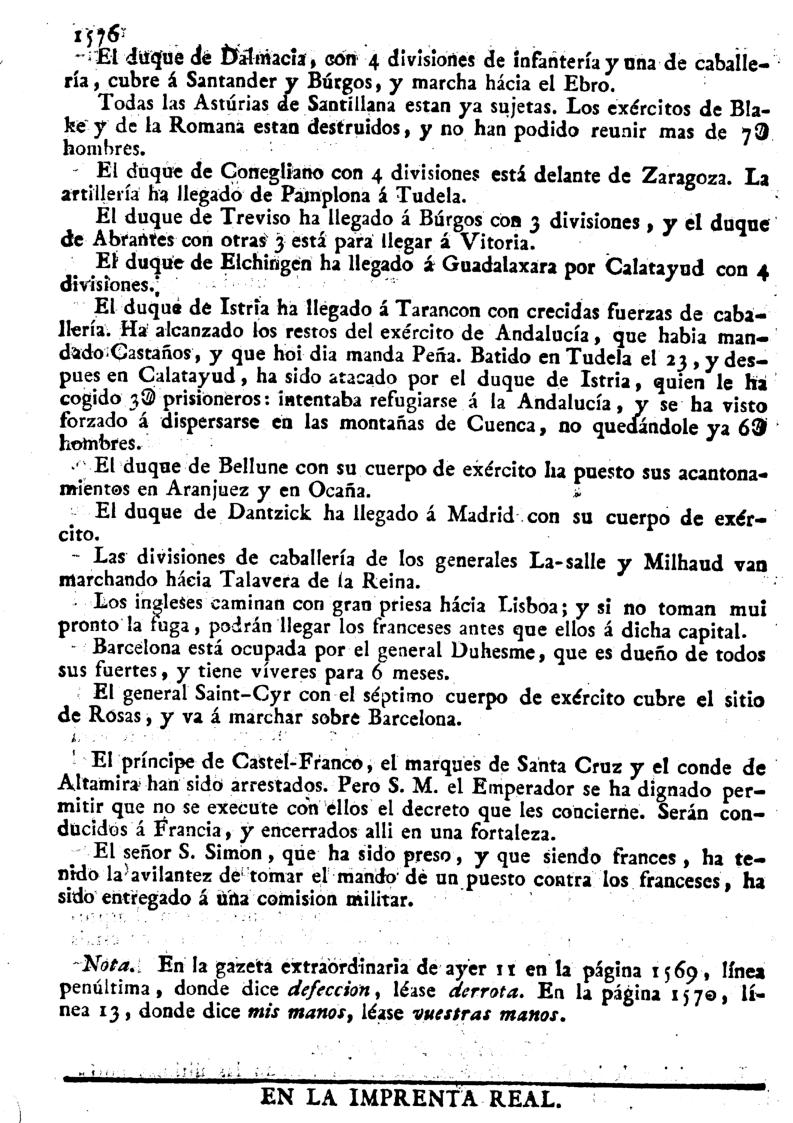The siege of Barcelona in 1808
The attempted reconquest of Barcelona by Spanish troops during the Peninsular War, was resolved in favour of French and Italian, who had surrounded the city of trenches. The Division of General Joseph Chabran occupied the north, Sant Andreu de Palomar, Horta and Gràcia, while the general Giuseppe Lechi, those of Sarrià, San Pedro Martyr, Sant Feliu de Llobregat, Cornellà de Llobregat and L’Hospitalet de Llobregat. The Spanish troops, were commanded by Captain General Domingo de Traggia. The regular troops, under the command of the count of Caldagués, were deployed to the right of the Llobregat and, while the 3,710 miquelets of Colonel Francesc Milans del Bosch watched the French positions on the side of the Besòs.
On 8 November 1808, the attack was produced, advancing through the Barcelona plan. The first column to enter into action was that of Caldagués that pushes the French to the Creu Coberta, near the portal of San Antonio, but the column of the general of Witte, which had to help by cutting the French withdrawal does not arrive on time because it cost crossing and The Chariot bridge in Sant Boi de Llobregat. The division of Colonel Gómez de la Serna manages to advance to Sarrià and Gràcia, leaving the position of St. Peter the martyr blocked. The division of Laguna conquers Sant Andreu de Palomar and rejects an attempt by general Goullus’s Brigade to retrieve it, which is withdrawn from Fort Pius. The column of Milans finally crosses the Besòs River by Sant Adrià in support of Laguna.
Duhesme, threatened by the two flanks, attempts to stop the attack on the left, on the one hand, strengthening the Italian Division with the 93th French-line Battalion and a squadron of Battlesbushes, and by another ordering the attack on Caldagués troops, making the early hour of the Afternoon, the Spaniards withdraw from Sants, returning to the initial positions on the other side of the Llobregat, while on the right, continue to occupy Horta and Sant Andreu de Palomar.
On 22 December, the Superior board of Catalonia left Vilafranca del Penedès for the imminent arrival of the imperial troops, which defeated the remains of the Spanish army in Molins de Rei and back to Tortosa, where they arrived on 29 December. General Duhesme is now the military governor of Barcelona.
To illustrate the story, this magnificent (literally) map, little known and exquisitely worked. We can find the Forte Pio (Fort Pius, which unfortunately, in my opinion, will end up becoming the Fort Pienc of modernity) near the street Marina. We can see, clearly, all the villas of Barcelona’s plain and the Llobregat Delta, the County Rec… It impresses the distribution of military forces. His title: CARTA DEI CONTORNI DI BARCELONA coll’ indicazione delle varie posizioni occupate nel blocco del 1808 per servire alla Storia Militare degli Italiani in Catalogna del Cav. VACANI MAGGIORE nell J.R. Corpo del Genio […] Italiani in Catalogna. The work of Camillo Vacani and Luigi Antonini.
The book, in Italian and especially Patriotic-Imperial , which contains the maps entitled: Storia delle campagne e degli assedj degl’italiani in Spagna : dal MDCCCVIII al MDCCCXIII. Vacani, Camillo, 1784-1862. You can find it at Biblioteca Virtual del Patrimonio Bibliogràfico.
And the BOE (Official State Gazette) of the time can be found here:
The war we have done so far in Catalonia has been a true school of ferocity and demoralization. [..] The fact that the generals have frequently ordered or tolerated looting, devastation, fire has greatly demoralized our troops. The conduct of our generals Duhesne and Lechi has not been, nor is it, the most conforming to justice. If you listen carefully, you will not hear another noise ringing between the hills of Horta, Gracia and Sarrià, between the banks of Llobregat al Besós, that the voices of robberies and pillages. Everything that is found, wheat, oil, wine, furniture animals and even parrot cages, everything is taken and taken to Barcelona to sell and get money.
Updated December 18, 2019. Related information can be found at Piscolabis Librorum.






